The coating consists of a combination of zinc oxide particles with antibacterial activity and hydroxyapatite particles, which is a calcium and phosphate mineral that also makes up the bones and teeth in our body, which helps the process of absorbing the implant in the body

In the world of medicine, there are currently a variety of implants for different purposes, from screws to connect bones to springs that prevent blockage of arteries. The implants mostly consist of metallic or plastic materials. Today, the procedure of transplanting implants is considered relatively safe and common, and millions of people around the world enjoy an upgraded quality of life thanks to it. However, the introduction of any foreign bone into the body brings with it risks of infections and a fusion problem between the implant and the tissues. To prevent these phenomena, "smart" coatings for implants have been developed in recent years.
In a new article by Uri Gawli from the research group of Prof. Danny Mandler from the Institute of Chemistry at the Hebrew University, and recently published in the journal 'Nano Materials', a new method for coating metallic implants with a bi-functional coating was presented. The coating consists of a combination of zinc oxide particles with antibacterial activity and hydroxyapatite particles, which is a calcium and phosphate mineral that also makes up the bones and teeth in our body, which helps the process of absorbing the implant in the body. How is the coating created? At first, the nanoparticles of the dust oxide ZnO and hydroxyapatite are created separately. After that, a small amount of organic additive is added to them, which expands and stabilizes them in the solution and gives them a positive charge. In the final step, a negative voltage is applied to the metallic implant that you want to observe, and the positive charge created on the particles causes them to sink onto the metal.
One of the significant advantages of this method, as opposed to others, is that it can be used to uniformly coat conductive substrates with complex geometry, such as screws. Also, in the accepted approach today, coating implants with hydroxyapatite is done by the spraying method at a very high temperature. Hence it is not possible to introduce a drug into hydroxyapatite in one step. In the new method, the drug is inserted as part of the hydroxyapatite coating.

In order to test the antibacterial activity of the coating, a comparison was made between a coated titanium surface and a bare surface. A significant growth of bacteria was observed on the exposed titanium surface, while no bacteria grew at all on the coated surface. In addition, the toxicity of the coating to human cells was tested, and it was found that the coating does not interfere with cell growth at all, which shows the high suitability of the coating for implants. These successful trials increase the chance that implants with this unique coating will indeed be suitable for medical use in the future.
Using a similar method, the researchers hope to add additional substances such as growth factors to hydroxyapatite. This approach can be applied to the coating of various implants such as dental implants with different and diverse coatings and hence it opens an opening for the preparation of "smart" implants in a simple and efficient way.
According to Prof. Mandler, "the field of functional coatings (the 'smart' ones) is developing at an incredible pace. In the field of medicine especially, there is a demand for coatings that will have multiple functions and the way of their placement will be simple. The approach presented in this work uses electrochemistry as the way of applying coatings, an approach that is used relatively little and at the same time, as you can see, gives significant advantages over other traditional approaches."

2 תגובות
Every day they are looking for the next thing that will bring more money into the coffers. Until recently, zirconia coating was "invented". Companies bought equipment, invested in technologies...but most dentists stayed with the titanium implants.
Such coating requires FDA approval. It must be proven that the coating is healthy for users and not unhealthy. It is necessary to carry out expensive controlled experiments to verify that there is no damage from a chemical substance in the mouth in prolonged contact with the skin. Does it not radiate, does not emit particles, is not toxic. A good question is if anyone is testing electro-chemical plating on the implant.
Apart from that: infections in artificial teeth are a very serious problem and if there is a solution, it should be examined